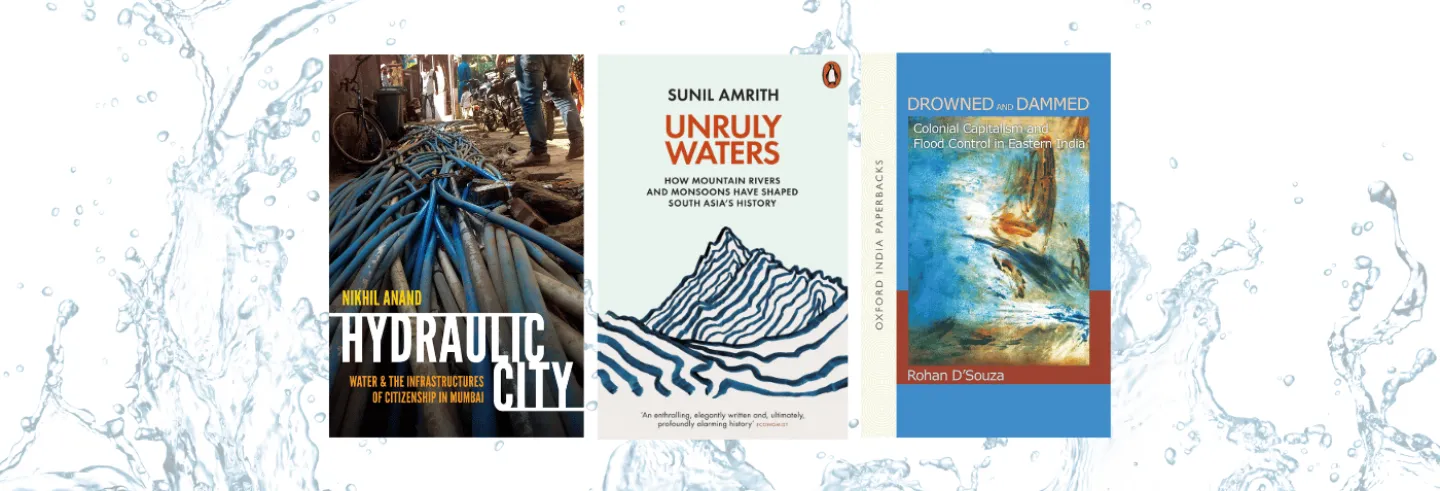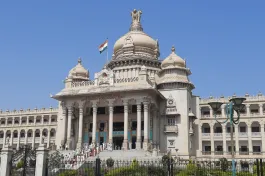We often tend to forget that water is not a watertight entity. Being fluid is at the heart of all sorts of hydraulic flows. Fluidity and flow are central to the politics that regulate, control, move, manage, divert, use and exploit water.
In this review essay, I want to conceptually identify and discuss common streams of thoughts that run through three fascinating books on water: Nikhil Anand’s Hydraulic City, Sunil Amrith’s Unruly Waters, and Rohan D’Souza’s Drowned and Dammed. The discussion will centre around the issues of fluidity and flow of water, though I shall also periodically discuss usage and wastage of water.
These three different writers rightly claim that many of the issues relating to shortage, wastage, misuse, and overflow of water arise due to the lack of cognizance of water’s fluidity and flow. The idea of fluidity of the flow is something that conceptually unifies these three exceptional works that investigate different aspects of flow, and the ways and means in which we exercise control over it.
Fluidity of Access, Hydraulic Citizenship, and Leakages
There is something essentially wrong when water is governed by a vision that conceives it as inflexible and stable—as opposed to conceiving it as a flowing body that is susceptible to spillages and leakages. In that context, the coinage of the term ‘leaky states’ by Nikhil Anand in Hydraulic City is appropriate. His work maps various aspects of the social life of urban water flows. How much is the flow? What is its duration? How much is the pressure? What determines water timing and its shortage? Who gets access and who contests access? These are some of the significant questions regarding the flow of water that are raised in Hydraulic City.
If we come to think of the elaborate urban networks of water, we must acknowledge the social inequality of access in the first place. A scarce resource is always a thoroughly contested social commodity. So is the case with water. The question of access—particularly by the poor—rests on a set of paralegal and perennial arrangements and negotiations. Claimants to water have to strike deals with plumbers, engineers, counsellors, and politicians. It is a complex social network of multiple negotiations. This everyday struggle connects the public with providers and their intermediaries.
The nature of this struggle over access to water determines the relationship with water, and it also determines the citizenship of the urban poor. Therefore, that citizenship is fundamentally ‘hydraulic’ in nature. ‘Belongingness’ is established, legal rights are exercised, state patronage is extended, and entitlements are articulated, all through water access. By the same logic, access to water determines class and reproduces class. Informal and improvised arrangements, and multiple local-level juggads guide the task of diverting flows and ensuring water access in cities. The nature of the struggle is such that it is an ongoing and continual process, without any possibilities of permanent resolution. This implies that the social negotiations to get and retain access are fluid in nature. Therefore, hydraulic citizenship premised on water access is uncertain. The flow of water, and the flow of power to access water are fundamentally fluid—always in the process of making and becoming. It rarely graduates to a status of assurance, unless one significantly rises up the class ladder.
Any effort, in the past or at present, that overlooks the fluid, flowing and flexible aspects of water, makes a colossal error. It has only led to irreversible and disastrous ecological consequences.
Anand makes us swim through the ‘social-material-assemble’ of the water distributive mechanism. That mechanism is like a ‘living’, ‘breathing’, and ‘leaking’ entity. Given the numerous amounts of repairs, upgradations and replacements of the materials that are subject to decay and denigration, the solid hardware, should also be viewed as fluid. The mammoth size and scale of the hardware of infrastructure ensures the impossibility of attending to each and every issue around leakage. The structure of ‘fluidity’ also applies to the nature of socio-political negotiations around leakage. Leakage-detection, leakage-management, leakage-prevention, leakage-fixing—everything becomes a matter of contestation, knowledge production, and prioritization in fixing certain things, and the neglect of some others. All of this is informally improvised. It, therefore, remains fundamentally fluid. What appears to be calculable and manageable at the macro-level is actually impossible to measure. It is difficult to detect and fix informally worked out micro-level arrangements of ‘leakages’. Such ‘leakage ‘arrangements unofficially provide water to a vast number of populations in any Indian metropolis, thus making the materiality of leakage socially beneficial. All this is possible because water is not watertight. It is fluid; it flows. ‘Leakiness’ is unpreventable due to the fluid characteristics of water.
Conversely, leakage is also a condition that manufactures a range of knowledge and ignorance about leakage. Not to forget that most of the leakages are located underground, hence they are out of sight. They remain hidden, invisible, or are difficult to detect and audit with accuracy. This ignorance of leakage undermines or contradicts the official data on the volume of flow and leakage. Production of ignorance is necessary to sustain the informal networks of water access. Beneficiaries and intermediaries—in association with informal technologies of repair and improvised access—help to sustaining this field of ignorance. Or conversely, the ignorance about the amount and extent of leakage is in itself a form of alternative form of knowledge. It structures the everyday of those who benefit from the water-leakages, and it also structures the relationship between the infrastructure, state, intermediaries and its beneficiaries. Knowledge of leakage could be ignored, and ignorance about leakage could be knowledgeable. What, when, which leakage to attend or ignore are socio-political questions, determined by the fluid being of water. Water is not ‘watertight’. After all. It is always flowing, spilling, and leaking.
Disturbing Fluidity and Flow by Pitting Land against Water
In his seminal work Drowned and Dammed (2006), Rohan D’Souza establishes the ecological cost of undermining natural flows and fluidity in the flood plains of Mahanadi since the colonial era. The centralized hydrological regime of imperial science is antagonistic to indigenous knowledge and wisdom on water, which has been cultivated through centuries. Counterproductive interventions by colonial powers convert a flood-dependent agrarian system into a flood-vulnerable region. It causes irreversible damage at every stage, as it completely misunderstands and undermines the hydraulic specificities of the region.
Earlier, localized understanding of flows and floods had a plethora of coping mechanisms to adjust and negotiate with normal as well as abnormal floods. These were carefully designed defensive strategies. Specific cropping patterns were chosen to adapt to flood risks. For example, a rice variety called Biali which required relatively less water was grown in the upper and upper middle region of the flood plain and Sarad which required more water was grown in the lowlands. In a drought year Biali would be more productive and Sarad would suffer; and, conversely, the reverse would happen during a flood year. Through this coping-mechanism, communities made the best possible use of floodwater. Excess spillover could be productively used. At the heart of such usage mechanism, what was the fundamental realization? Fluidity of water. Land and water, or water that surrounded the land from all sides in a delta region were not seen as antagonistic entities that had to be separated, barricaded, insulated for the purpose of cultivation. Rather, the flow of excess water was productively put to use. The dangers of excess were minimized by intelligent cropping patterns. Land was made more productive by treating the excess flow of water as a source of fertile silt. Citing another example of ecological harmony, D’Souza mentions how the muddy waters were conducive for young fish that survived on mosquitoes, thereby reducing malaria.
Reorganizing our thoughts on water, or redirecting them with an open mind, may rejuvenate a few dying flows. It may help us to think beyond mindlessly damming rivers, extracting groundwater, dumping rivers with trash, and take initiatives towards reviving catchments.
The overflow irrigation, which was beneficial for the farmers, was seen as a problem by the colonial administration. Instead of harnessing the excess water, they wanted to keep water out of the fields for the generation of an assured agrarian surplus. By ‘positioning land against water’, they disturbed the ‘hydraulic volatility’ of the regions, which went against the grain of fluidity and its free flow. State policy and community wisdom get into a conflict beyond negotiation. While access to water is negotiated by the community of urban dwellers in Anand’s work, in the Mahanadi basin imperial technological prowess is imposed. D’Souza spends a considerable time and effort to explain the lack of logic in the colonial land water separation. He maps how such a separation was conducive to the larger capitalist appropriation—manifested through rental extractions. Land and water were increasingly conceived as separate commodities to be differently tamed, disciplined, conquered, utilized, and administered.
Earlier social entanglements between the peasants and the intermediaries were dismantled in favour of an inflexible and extractive mechanism, which was unsympathetic to crop failures due to the floods. Exclusive property rights replaced the Mughal-Maratha revenue system that viewed an entire village as a productive unit. The earlier system helped to average out good and bad yields of an entire village, and cope better with crop fluctuation. It worked on the presumption that good crop years will follow bad ones, and bad ones will successively follow good ones. Instead of expecting agrarian surplus in ‘uneven waves’, the colonial revenue system was insensitive to ecological specificities. It was also indifferent to the usefulness of excess flows in the region. It was equally indifferent to the trustworthiness and intertwined social relationships of entitlements and patronization between the peasants, intermediaries and the emperor, which used to facilitate investments, maintenance and revenue waiver, though this would have presumably benefitted those who owned land and not the landless.
In a system of impersonalized rent collection in the colonial era, the collectors were disassociated and detached from the peasants. Successive shifts in the hydraulic regime, such as construction of permanent embankments and dams, were based on a neat separation of land and water. Its sole objective was to protect the land from water—a separation that stems from disrespecting the flows and fluidity of water. It posed water as dangerous by undermining the organic fluidity and flow of water. It eventually resulted in making the plain increasingly more flood prone. By posing extra flow as a real and perceived threat, and by imposing engineering models of strict control, it risked land, life and livelihoods.
Unruly Flows and Hydraulic Elasticity
Sunil Amrith’s Unruly Waters (2018) emphasizes a more fluid sense of geography. He proposes a fluid understanding of the fluidity. He argues that the materiality of the flow, confined to ‘two-dimensional space between points on a map’ is extremely problematic. The flow that precedes political boundaries, imperial ambitions, and technological prowess is increasingly undermined by those political boundaries. Frontiers have an impact on flows because we are unable to develop a flexible conception of both flow and space. He urges scholars to look beyond a two-dimensionality of water by reiterating the need for adding ‘depth’ and ‘altitude’ to understand flow and fluidity.
Amrith offers agency to water by foregrounding water that defines and determines everything. Water is not only a yardstick of technological prowess, providing oceanic trade routes for imperialistic ambitions, but according to Amrith, water has been truly unruly. The unruliness refers to uncontrollable, unpredictable and disruptive hydraulic flows, particularly the seasonal rains that have transformed the subcontinent’s hydrology and history. Like D’Souza, Anand also provides a critique of how gigantic engineering solutions have prevailed at the expense of local peoples and environments. Fluidity of water that connects cultures and geographies has been compromised.
Any effort, in the past or at present, that overlooks the fluid, flowing and flexible aspects of water, makes a colossal error. It has only led to irreversible and disastrous ecological consequences. There is a direct relationship between such flawed hydraulic imagination and the current water crisis. In a spree to control, conquer and harness nature, our engineering arrogance has often altered the human relationship with water and nature at various nodal points. Salination, groundwater depletion, loss of soil fertility, and toxicity are some of the obvious consequences. To rectify some of this before it is too late, we have to tune out imagination, interaction and usage by taking cognizance of the inherent fluidity of the flow.
Our urge to manoeuvre and manipulate; control and direct water goes essentially against the grain of its ‘flow’ and ‘fluidity’.
It is imperative to ask a few basic questions: if water is unruly, to what extent does it need to be ruled, if at all? What are the ecological and human costs of taming it to an extent that we either scuffle it, or reserve the advantages of flow for a privileged few? If it is leaky, whom does the leakage socially cater to, and under what social circumstances? If it is bound to spill, what are the healthy benefits of allowing it to overflow? Reorganizing our thoughts on water, or redirecting them with an open mind, may rejuvenate a few dying flows. It may help us to think beyond mindlessly damming rivers, extracting groundwater, dumping rivers with trash, and take initiatives towards reviving catchments. Rigidity has caused enough harm. Some flexibility could cause less harm and more benefits.
The anthropogenic imagination that aims to make water ‘watertight’ and keep it under absolute control is problematic because it is simply not water’s nature to remain confined. The need for making water watertight with the objective of ensuring no spillage is not just ecologically impossible, but it is also not socially viable. Water needs to flow. It needs to reach. Fluidity is a core idea behind understanding water, and the politics and policies around it. Because it is fluid, or because of its ability to flow, it can be made to travel from a water-abundant region to a water-scarce region; from the dams to the canals to the fields; from less privileged zones to more privileged zones; from underground reserves to overhead tanks; from factories to packaged bottles; from rivers to oceans; from bathrooms to drains; and through many such pathways. Our urge to manoeuvre and manipulate; control and direct water goes essentially against the grain of its ‘flow’ and ‘fluidity’.
Sreedeep Bhattacharya is Associate Professor, School of Humanities and Social Sciences at Shiv Nadar University.









